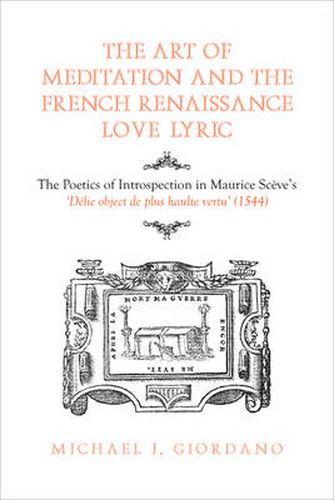Readings Newsletter
Become a Readings Member to make your shopping experience even easier.
Sign in or sign up for free!
You’re not far away from qualifying for FREE standard shipping within Australia
You’ve qualified for FREE standard shipping within Australia
The cart is loading…






The Art of Meditation and the French Renaissance Love Lyric examines the poetics of meditation in the French love lyric at the height of the Lyonnais Renaissance as illustrated by one of the country’s most prominent writers. Maurice Sc ve’s D lie is the first French sequence of poems devoted to a single woman in the manner of Petrarch’s Rime. It is also the first Renaissance work to use emblems in a sustained work on love. At their core, most amatory lyrics involve a triple relation among lover, beloved, and the meaning of love. Whether the poet-lover is a man or woman, poetic discourse generally takes the form of an interior monologue frequently intermingled with direct and indirect address to the beloved. Though the dominant quality of this lyric is personal introspection, Michael Giordano finds D lie to be consistent with traditions of Christian meditation. He argues that the amatory lyric served as a vehicle for contests of value and paradigm change not only because it was conditioned both by sacred and profane sources, but also because it occurred at a time of religious upheaval and scientific revolution.
$9.00 standard shipping within Australia
FREE standard shipping within Australia for orders over $100.00
Express & International shipping calculated at checkout
The Art of Meditation and the French Renaissance Love Lyric examines the poetics of meditation in the French love lyric at the height of the Lyonnais Renaissance as illustrated by one of the country’s most prominent writers. Maurice Sc ve’s D lie is the first French sequence of poems devoted to a single woman in the manner of Petrarch’s Rime. It is also the first Renaissance work to use emblems in a sustained work on love. At their core, most amatory lyrics involve a triple relation among lover, beloved, and the meaning of love. Whether the poet-lover is a man or woman, poetic discourse generally takes the form of an interior monologue frequently intermingled with direct and indirect address to the beloved. Though the dominant quality of this lyric is personal introspection, Michael Giordano finds D lie to be consistent with traditions of Christian meditation. He argues that the amatory lyric served as a vehicle for contests of value and paradigm change not only because it was conditioned both by sacred and profane sources, but also because it occurred at a time of religious upheaval and scientific revolution.